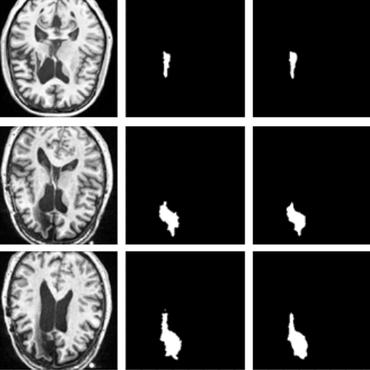Lesion Segmentation
208 papers with code • 10 benchmarks • 13 datasets
Lesion segmentation is the task of segmenting out lesions from other objects in medical based images.
( Image credit: D-UNet )
Libraries
Use these libraries to find Lesion Segmentation models and implementationsDatasets
Most implemented papers
U-Net: Convolutional Networks for Biomedical Image Segmentation
There is large consent that successful training of deep networks requires many thousand annotated training samples.
Encoder-Decoder with Atrous Separable Convolution for Semantic Image Segmentation
The former networks are able to encode multi-scale contextual information by probing the incoming features with filters or pooling operations at multiple rates and multiple effective fields-of-view, while the latter networks can capture sharper object boundaries by gradually recovering the spatial information.
SegNet: A Deep Convolutional Encoder-Decoder Architecture for Image Segmentation
We show that SegNet provides good performance with competitive inference time and more efficient inference memory-wise as compared to other architectures.
Pyramid Scene Parsing Network
Scene parsing is challenging for unrestricted open vocabulary and diverse scenes.
Skin Lesion Analysis Toward Melanoma Detection 2018: A Challenge Hosted by the International Skin Imaging Collaboration (ISIC)
This work summarizes the results of the largest skin image analysis challenge in the world, hosted by the International Skin Imaging Collaboration (ISIC), a global partnership that has organized the world's largest public repository of dermoscopic images of skin.
Road Extraction by Deep Residual U-Net
Road extraction from aerial images has been a hot research topic in the field of remote sensing image analysis.
Skin Lesion Analysis Toward Melanoma Detection: A Challenge at the 2017 International Symposium on Biomedical Imaging (ISBI), Hosted by the International Skin Imaging Collaboration (ISIC)
This article describes the design, implementation, and results of the latest installment of the dermoscopic image analysis benchmark challenge.
Recurrent Residual Convolutional Neural Network based on U-Net (R2U-Net) for Medical Image Segmentation
In this paper, we propose a Recurrent Convolutional Neural Network (RCNN) based on U-Net as well as a Recurrent Residual Convolutional Neural Network (RRCNN) based on U-Net models, which are named RU-Net and R2U-Net respectively.
A Novel Focal Tversky loss function with improved Attention U-Net for lesion segmentation
We propose a generalized focal loss function based on the Tversky index to address the issue of data imbalance in medical image segmentation.
Boundary loss for highly unbalanced segmentation
We propose a boundary loss, which takes the form of a distance metric on the space of contours, not regions.











 HAM10000
HAM10000
 DigestPath
DigestPath
 ISIC 2018 Task 1
ISIC 2018 Task 1
 ISIC 2017 Task 1
ISIC 2017 Task 1
 FGADR
FGADR
 University of Waterloo skin cancer database
University of Waterloo skin cancer database
 ISIC 2018 Task 3
ISIC 2018 Task 3

